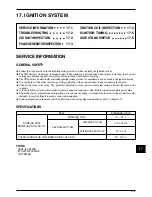
16-1
16. BATTERY/CHARGING SYSTEM
SERVICE INFORMATION
·
Do not place flammable materials near battery when charging. This can be a fire hazard as hydrogen gas is created
during charging battery.
·
Do not allow battery acid to come into contact with clothes, skin or eyes. Battery acid contact can cause burns or loss of
eye sight. If contact occurs, thoroughly clean with water, and if acid enters eyes, flush with water and see a doctor.
·
If battery acid gets on clothing, as it can seep through or make a hole through the clothing and make its way to the skin,
make sure to change clothing that has come into contact with battery acid and wash the battery acid from the clothes.
·
This vehicle has a maintenance-free(MF) battery. Because MF batteries use different charging equipment, take special
care when performing maintenance and especially when replacing parts. Not all regular battery equipment is
compatible with MF batteries.
·
When charging the battery, remove the battery from the frame.
·
There is the possibility of damaging the regulator/rectifier, etc. if the terminal or coupler is separated/connected when
electricity is over flowing through the electrical devices. Make sure to turn the main switch OFF when performing
maintenance to the charging equipment.
●
If the battery is allowed to repeatedly lose all its charge, is repeatedly over-charged, or if it is left in an un-charged state,
the battery can be damaged, its life can be reduced, or it can lose some of its strength. It is important to note here that the
battery will naturally last 2-3 years of normal use, and although it will re-charge, its load is reduced, leading to a loss in
battery strength.
●
It is possible for the battery to become overcharged from battery body load. If a battery cell becomes short-circuited and
if a state develops where voltage is not created between the terminals, the regulator will not operate and excessive
voltage will develop in the battery and normal cell electrolytes will decrease.
●
If the vehicle is not used for a long period, make sure to chage the battery every three months. If not so, the battery
ability to store electricity is reduced.
●
For information on generator disassembly, refer to section 8.
16
SERVICE INFORMATION
·
··
··
··
··
·
16-1
TROUBLESHOOTING
·
··
··
··
··
··
·
16-2
BATTERY
·
··
··
··
··
··
··
··
··
··
··
·
16-3
CHARGING SYSTEM INSPECTION
·
·
16-4
ITEM
STANDARD VALUES
SPECIFICATIONS
REGULATOR /
RECTIFIER
Capacity
Terminal-to-terminal voltage (When fully charged)
Charging Current
Current leakage
Charging Coil resistance value ( 20
°
C )
rpm at Charging Start
Type
Regulated Voltage
12V - 10AH (MF)
13.0-13.2V
1.0A
Not to exceed 1mA
0.1-1.0
Ω
(20
°
C
)
1,600 rpm (night load)
Thyristor system
14.5
±
0.5V / 5,000(rpm)
TOOLS
DIGITAL TESTER, PVA MULTI-TESTER, BATTERY TESTER
REGULATOR/RECTIFIER
·
··
··
··
·
16-5
A.C. GENERATOR CHARGING COIL
INSPECTION
·
··
··
··
··
··
··
··
·
16-6
BATTERY
A.C.GENERATOR
Summary of Contents for ROADWIN VJ125 - SERVICE
Page 3: ......
Page 23: ...MEMO...
Page 39: ...MEMO...
Page 47: ...4 0 FUEL SYSTEM...
Page 60: ...MEMO...
Page 61: ...5 0 COOLING SYSTEM...
Page 64: ...MEMO...
Page 65: ...6 0 ENGINE REMOVAL INSTALLATION...
Page 69: ...7 0 CLUTCH GEARSHIFT...
Page 82: ...MEMO...
Page 83: ...8 0 A C GENERATOR STARTER CLUTCH...
Page 93: ...9 0 CYLINDER HEAD VALVES...
Page 109: ...10 0 CYLINDER PISTON...
Page 116: ...MEMO...
Page 117: ...11 0 CRANKCASE TRANSMISSION CRANKSHAFT...
Page 130: ...MEMO...
Page 131: ...12 0 EXTERNAL PARTS...
Page 137: ...13 0 FRONT WHEEL FRONT FORK STEERING...
Page 161: ...14 0 REAR WHEEL REAR SUSPENSION...
Page 174: ...MEMO...
Page 175: ...15 0 HYDRAULIC BRAKE FRONT REAR...
Page 200: ...MEMO...
Page 208: ...MEMO...
Page 216: ...MEMO...
Page 228: ...MEMO...
Page 241: ...MEMO...
Page 249: ...MEMO...
Page 250: ...MEMO...
Page 251: ...SERVICEMANUAL 2004 1 PRINTED 2004 1 PUBLICATION NO C COPY...
















































